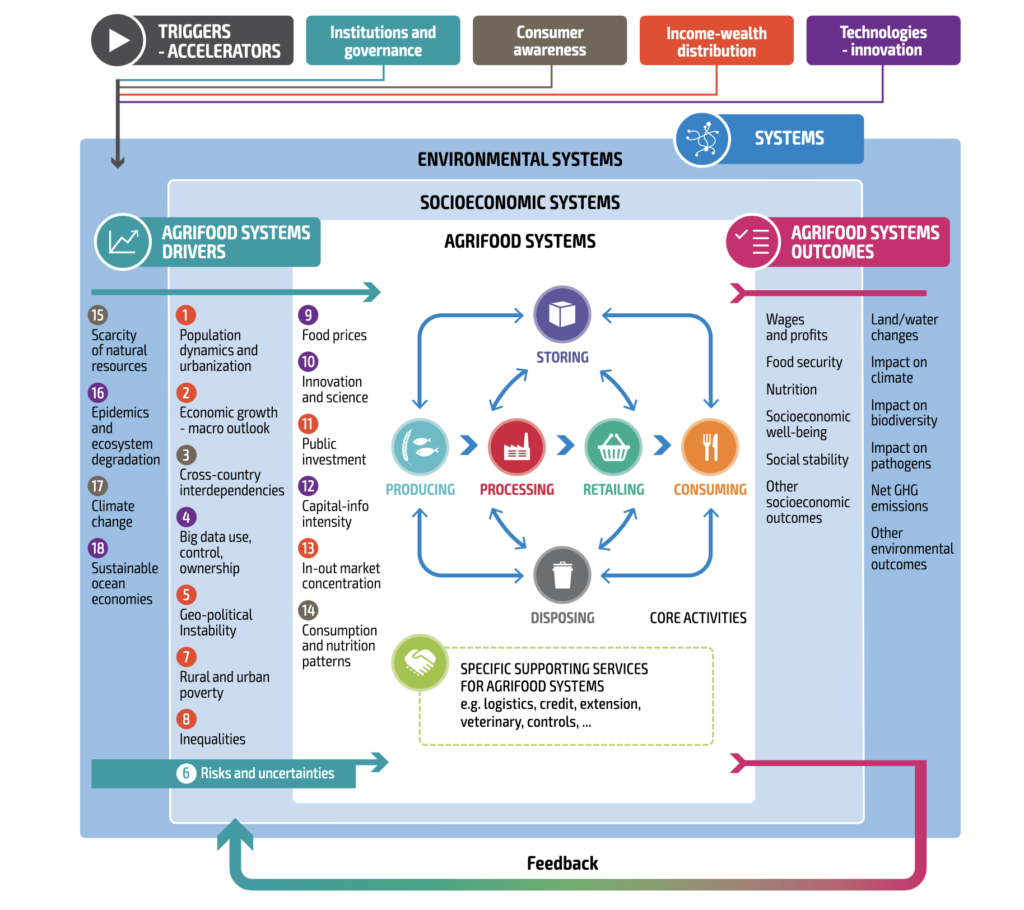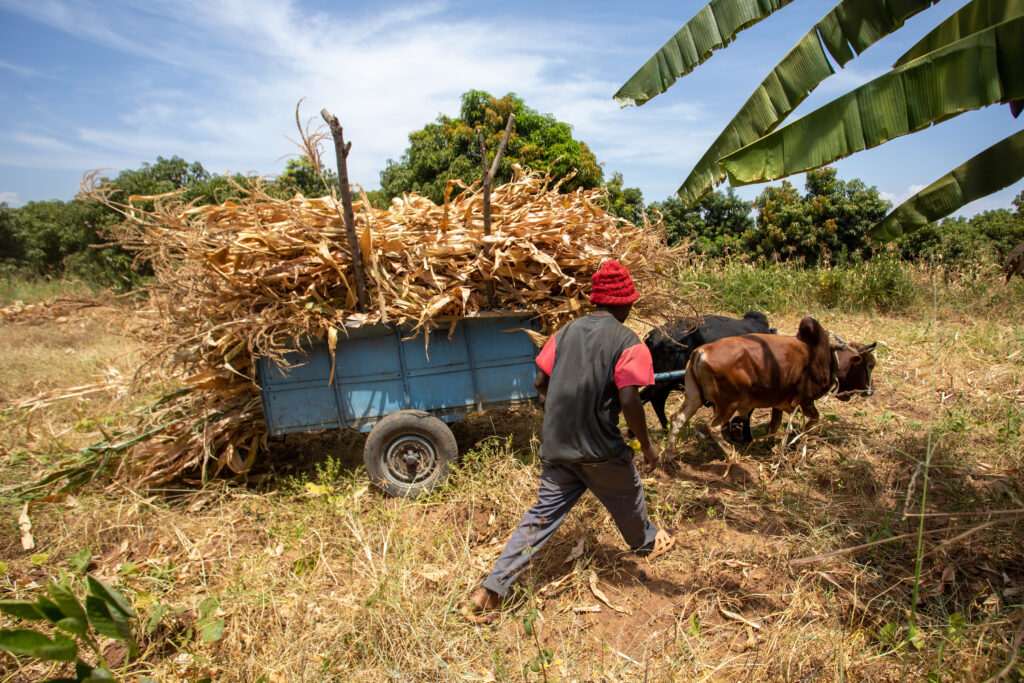The global food system needs to be transformed. It needs to deliver better health and improved livelihoods while protecting the environment and minimizing negative social impacts.
However, there are many interconnected factors playing a role. Food Systems are complex adaptive systems which require a deep analysis of their various driving forces and dynamics. They are shaped by a multitude of interconnected factors or drivers, some well-defined, others with a lot of uncertainties with them. A recent study by Forsight4Food identified the most critical drivers of the global food system as described by a set of 19 recent foresight reports. It was not easy to define and categorize these very drivers, and we will also discuss these challenges in this blog.
The Entangled Web of Drivers
Many studies, from the 2003 Millennium Assessment report to FAO 2022 have defined what is a ‘driver’. But the challenge is the lack of a universally agreed-upon definition for a driver. This means that categorizing these drivers is problematic. For instance, they can be classified based on their relationship with other drivers (direct or indirect), external factors (like PESTLE analysis- Political, Economic, Sociological, Technological, Legal and Environmental), or the extent of our knowledge about them (known knowns or unknown unknown).
What makes it even more intricate is that, due to the systemic nature of the food system, its nutrition, environmental condition, and economic development outcomes feedback indirectly becomes driver themselves. This creates feedback loops that complicate pinpointing which drivers are truly direct and which are indirect. Ultimately, it depends on the specific part of the system you’re focusing on. This is nicely depicted in the FAO’s food system diagram, however, it does not show the interconnections between different factors which is what needs careful consideration.

Source: FAO 2022
Here’s another layer of complexity: There are “known knowns” drivers like climate change and population growth and many models have been developed to understand the future trend. Then there are drivers such as government interventions (trade policies and subsidies) which is undoubtedly an important driver, but predicting the future impact of specific interventions is challenging. Similarly, we understand that diets are shifting towards more protein, but whether this trend holds true depends on the specific scenario we’re considering. These are “known unknowns” – we know they exist, but their future impact is a mystery. But the complexity is even deeper: “unknown unknowns”. Take the influence of social media on food choices. This is a relatively new area of study, and its full impact on the food system remains unclear. There can be overlaps in any type of categorisation system. Therefore, it is important to involve experts at this stage.
Identifying the Critical Few
The next hurdle is identifying “critical drivers” – those with the most significant potential to impact the food system. These drivers can influence various stages through established historical trends or emerging uncertainties. A key challenge lies in determining their relative importance across diverse contexts, often depending on stakeholder perspectives. For instance, immigration policies can have a significant impact on agricultural workforces in some regions. Incorporating stakeholder consultations is crucial to prioritize the most impactful drivers in these specific contexts.
Keeping the Conversation Open
It’s vital to remember that the impacts of drivers manifest differently across various socio-economic settings and among different food systems stakeholders. Highlighting the context in which a driver is critical helps us develop more targeted solutions.
We must also acknowledge that new or emerging drivers with unclear trends can also have profound impacts. For example, as mentioned earlier, the role of social media in influencing food choices is a relatively new area of study.
Therefore, the conversation around identifying critical drivers needs to be open to periodic updates. As we uncover new information and witness the emergence of new drivers, we can refine our understanding of the food system and adapt our strategies accordingly.
Future Trends and Projections
The future trajectory of these drivers is influenced by various factors, both internal and external to the system. Climate change, consumer behaviour, and technological advancements all play a role in shaping the path ahead. These complexities of cross-impacts create uncertainties about the future, often interpreted through different assumptions in various projections.
Many reports from IPCC, FAO and UNDP present some of the trends and projected trends around food system drivers. But these vary due to the underlying assumptions. Moreover, deciphering these projections can be challenging due to two key factors: 1) varying timescales and 2) diverse representations of what a sustainable food system actually looks like. However, by delving deeper into these assumptions and comparing them, we can gain a more comprehensive understanding of the possible futures that lie ahead.



What we found…
The review of recent studies on food system drivers revealed a mix of established and emerging influences. We categorised drivers using the known-knowns and known-unknowns classification. Long-standing factors like demographic changes, climate issues, technological innovation, resource efficiency, socio-economic inequalities, government interventions, health considerations and level of connectivity continue to shape food systems, while new drivers such as the rise of e-commerce post-COVID-19, concerns about power imbalances in food value chains, labelling and packaging, data ownership issues, the role of indigenous knowledge, labour migration policies and perceptions around vegan and vegetarian diets are gaining importance. The relevance of these drivers varies based on stakeholder perceptions, indicating the diverse issues decision-makers must consider for effective management and adaptation.
The review also noted varying levels of uncertainty associated with these drivers. Established drivers, such as demographic trends, have narrower uncertainty ranges due to extensive research, leading to more consistent projections. However, differences in time frames, methods, and assumptions among studies complicate direct comparisons of quantitative trends. Emerging drivers, like government interventions and social media’s influence on consumer behaviour, exhibit broader uncertainty ranges and diverse trend directions, making them particularly significant for developing future scenarios. Our upcoming report will discuss these critical points in detail.
Conclusion
Transforming global food systems to deliver better outcomes is a complex and urgent challenge. Understanding the critical drivers shaping these systems, both well-known and emerging, is essential for creating the societal understanding and political will needed for meaningful change. Just as a map evolves with new discoveries, our understanding of these critical drivers needs constant refinement. Through ongoing research, collaboration, and open communication, we can navigate the complexities of the food system and support targeted solutions towards a more sustainable food system.